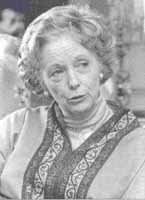 OBITUARY - The Daily Telegraph
OBITUARY - The Daily Telegraph
AUTHOR OF THE FAR PAVILIONS WHO WAS INSPIRED BY HER EXPERIENCES AS A CHILD OF THE RAJ
THE DAILY TELEGRAPH, Saturday, January 31, 2004. Page 29, Obituaries. Picture of M M Kaye by Camera Press
M M Kaye, who died on Thursday aged 95, was the author of The Far Pavilions (1978), a 1,000 page epic of war and romance set in 19th century India; the book sold in its millions and was adapted for television in 1984, when it was broadcast as a six-hour mini-series on Channel Four, starring Ben Cross and Amy Irving and featuring Omar Sharif, Christopher Lee and Sir John Gieldgud.
Mollie Kaye as brought up in pre-Independence India, and had published a number of books with little success when she produced The Far Pavilions. It had taken her 15 years to write. The book (described by one critic as “the Gone with the Wind of the North-West Frontier”) is about a love affair between an Indian-born Englishman, Ashton Pelham-Martyn, and Anjuli, an Indian girl.
In many ways it was a page-turning blockbuster; treachery, intrigue and passion abounded as spoiled and wilful concubines assassinated their way to power, while the hero and heroine made dashing midnight escapes and sealed their love in a raging sandstorm. But The Far Pavilions was also a detailed depiction of Mollie Kaye’s own love affair with a country that she always referred to as “home”. Every last detail, from the wildflowers that grew on the Himalayas to the complicated caste system, was informed by her own enchanted childhood, which she described as “living in paradise”.
Mary Margaret Kaye was born at Simla, in the foothills of the Himalayas, on August 21, 1908. Her father, Sir Cecil Kaye, was in the Indian Civil Service. A cipher expert, whom the Indians reluctantly admitted was “unbribable”, Cecil was on Kitchener’s staff. Mollie’s grandfather, brother and husband also served the Raj, while a cousin, Edward Kaye, commanded a battery during the siege of Delhi in the Mutiny. John Kaye, Edward’s brother, wrote the official history of the Mutiny and the First Afghan War. As a child, Mollie lived in Curzon House and played in the garden among the very gun emplacements which her ancestors had commanded.
While Cecil, who spoke nine languages and twice as many dialects, travelled the country, his beautiful and vivacious wife Daisy was preoccupied with a never-ending round of parties. The children, meanwhile, spent much of their time with the Indian servants, and Mollie spoke Hindustani before she mastered English. Her early schooling, however, was haphazard. “My parents,” she later recalled, “were of the generation who thought girls didn’t need a proper education, so long as they read a lot.”
Along with her brother and sister, she shared a governess with other families, “but there was little to do but feed the birds and squirrels in the luxuriant tropical gardens”. Indeed, the children were unaware that they were not Indian themselves. “I never thought for a moment that I was not one of them,” she explained. “I was merely a member of a different caste in a land full of castes.” When she was 10, Mollie was sent to England to be formally educated. “I found the place incredibly drear,” she said, “so cold and colourless.” Boarding school was “hell” and, bullied by the other girls, she and her sister would “say rude tings about the pupils” in Hindustani.
After leaving school, Mollie Kaye stayed on in England to attend art school, where she studied children’s book illustration and supported herself by making Christmas cards. She also found work illustrating a novel which she thought so badly written that she decided to do better - and did, writing a thriller for which she received a cheque for £64 from the publishers. “ I didn’t mean to be a writer,” she aid later. “If it had been sent back, I wouldn’t’ have tried again.” The money was enough, however, to buy a return passage to Bombay.
Soon after her return to India she met her future husband, Goff Hamilton, an officer in Queen Victoria’s Own Corps of Guides. The dashing soldier, who had been awarded the DSO at the age of 23 when he was serving on the North-West Frontier, swept her off her feet. He would later be the inspiration for Ash in The Far Pavilions.
Mollie Kaye married Goff Hamilton in India on Armistice Day, 1945. Years later she recalled the birth of the first of their two daughters: “The baby took five days and nights to arrive and we both nearly died. A tiger ate the hospital water-buffalo and the doctor sat up all night and finally shot it. Moths flew out of the chloroform bottle. I caught malaria because mosquitoes were breeding in the hospital water-tank. It was just so hilarious… utterly loony. It could only happen in India.”
She went back to writing after the birth of her second daughter, eventually publishing Shadow of the Moon (1957), her first historical novel, which set during the Indian Mutiny. The material for the book had come to her by a stroke of good fortune: while staying with friends she had discovered in an outhouse some transcripts of Mutiny trials. Using them for research, she was able to provide a wealth of accurate detail in her book. She was therefore infuriated when it was savagely cut by the publisher, leaving it as little more than a romance. But in 1979, following the success of The Far Pavilions, Shadow of the Moon was among a number of her books to be re-published. It was restored to its full length, including some excruciating details of Mutiny atrocities, and sold well.
After Partition, Mollie Kaye’s husband transferred to the British Army and spent almost two decades as an Army wife, making a home wherever she was posted; there were spells in Kenya, Berlin, Zanzibar and Cyprus.
Mollie Kaye took advantage of every moment, and their postings became settings for a series of detective novels. They included Death Walks in Kashmir (1953); Death Walks in Berlin (1955); Death Walks in Cyprus (1956); and Later Than You Think (1958), which was written while her husband’s regiment was engaged in the struggle against the Mau Mau. All these books were reprinted under different tiles after The Far Pavilions gave new sales impetus to anything under her name.
During the 1950s Mollie Kaye’s agent was Paul Scott, who was embarking on the Raj Quartet, his own epic about expatriate life in India. Scott had been to India during the war and had become fascinated by it; but he knew nothing of the country before the war. Mollie Kaye provided Scott with many stories of life in India in the 1920s; indeed, their collaboration was so close that it was she who suggested to him the theme of his most successful novel, Staying On. The Far Pavilions sold more than 15 million copies, and was so popular that travel companies organised trips to India for tourists to visit the sights immortalised in the story.
In 1990 Mollie Kaye published The Sun in the Morning, the first of her three-volume autobiography, Share of Summer. “Someone once said,” she wrote, “that however long you lived, however far you travelled, the streets and roads you played in as a child would always be home to you. As far as I am concerned, that it is true.” The second and third volumes were Golden Afternoon (1997) and Enchanted Evening (1990). She was planning a fourth volume at the time of her death.
Under the name Mollie Kaye she also wrote a number of books for children, including the Potter Pinner series (1937-41); The Ordinary Princess (1980) and Thistledown (1981). In addition she edited the Golden Calm, a diary of post-Mutiny India written by an Englishwoman, and wrote a history of the Corps of Guides.
Following Goff Hamilton’s retirement in 1962, the couple settled in Sussex (“I picked it,” she explained, “because Kipling lived here”). Hamilton devoted much of his time to supporting Mollie Kaye’s writing career, helping her correct the manuscript for The Far Pavilions. “Moll was a damn good soldier’s wife.” He would say, “moved 22 times in 17 years without a complaint… so now I’m retired, I’m happy to be the taxi, bag carrier and aide-de-camp.” Both were accomplished water colourists.
She was devastated when he died in 1985: “I have no idea how to set about living without him,” she said. “How on earth, does one do it, after falling in love with a chap on sight and staying in love with him for almost 45 years?” From 1987 she lived with her sister, Betty, in a wing of her daughter’s house in Hampshire, moving to Suffolk, in 2001.
In later life she continued to recall the delights of growing up in India and would describe in minute detail the peacocks, the bougainvillea, the corpses in the Ganges. “No one else will ever again live the kind of life that I have lived,” she wrote, “or see what I saw.”
Mollie Kaye is survived by her two daughters and by a step-daughter.
